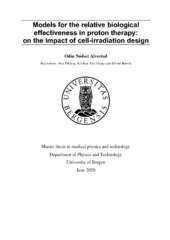| dc.description.abstract | Background: The use of protons was first suggested for use in treating cancer in 1946, due to its preferable dose distribution. In clinical practice, a constant Relative Biological Effectiveness (RBE) of 1.1 is used in treatment planning for protons, to account for the difference in biological effects between photon and proton irradiation. The RBE is, however, known to vary with variables such as physical dose levels, tissue type and Linear Energy Transfer (LET). RBE models are generally based on data derived from in vitro experiments. The aim of this study was to investigate how the restrictions of input data affect the estimates of RBE for protons predicted by such models. Methods: A database containing 98 in vitro experiments was gathered for this thesis. The database was divided into smaller homogenous databases, using the SPSS Two Step clustering algorithm. These databases were fitted to common equations for RBE_min and RBE_max. Finally, a Monte Carlo (MC) simulation was performed in order to recalculate the dose response in a spread out Bragg peak (SOBP), delivered to a planning target volume (PTV), predicted using the obtained RBE limits. Results: The cluster analysis divided our database into five clusters of different sizes. The fitting process provided fitting variables in the range of -0.031 to 0.097 (keV/μm)^(-1) for RBE_min, and -0.006 to 1.271 Gy(keV/μm)^(-1) for RBE_max. Furthermore, the recalculations predicted doses in the range of 0.60 to 3.50 Gy(RBE) to the PTV, whereas the highest dose values were located in the distal edge of the SOBP. Conclusion: Databases overrepresented by high α values, thus high (α/β)_x values, seemed to predict the highest doses. High D_min databases also predicted high doses. Databases representing low LET_d, and low α values, predicted the lowest doses in this study. | en_US |
